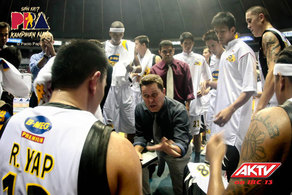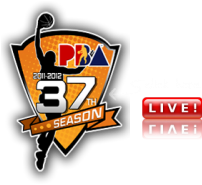
Excerpted from “Passing Glory,” a profile of B-MEG Llamados coach Tim Cone for the December 2011 issue of Esquire Philippines, on sale now
ON THE SIDES OF TIM CONE’S FACE are sharp, dark ridges that turn deep into the sockets of his eyes. He looks like he hasn’t had much sleep; his new team, the B-MEG Llamados, had lost three of its first four games in the new season of Philippine Basketball Association. But then it’s hard to imagine Cone getting much sleep over the past 22 years, a period in which he coached – and won – more PBA games than anybody else in league history.
ON THE SIDES OF TIM CONE’S FACE are sharp, dark ridges that turn deep into the sockets of his eyes. He looks like he hasn’t had much sleep; his new team, the B-MEG Llamados, had lost three of its first four games in the new season of Philippine Basketball Association. But then it’s hard to imagine Cone getting much sleep over the past 22 years, a period in which he coached – and won – more PBA games than anybody else in league history.
It shows on his face, with its lines and wrinkles: every blown defensive rotation by his players, every bad call by the referees, every bad jumpshot taken too early in the shotclock seems to have left their mark. He knows it, too.
“That’s why I hate getting photos taken,” he says. “In my mind, I always look like I’m 35. So when I see a picture of me, I’m like, ‘Oh my god, I look terrible.’”
There figures to be more wrinkles ahead as he continues to adjust to his new team, which he joined barely in September to a lot of fanfare and excitement. The erstwhile Purefoods franchise has one of the strongest lineups in the league, including two-time Most Valuable Player James Yap, perhaps the most transcendent talent of his generation. After Cone’s hiring, expectations had skyrocketed, and most observers pegged the Llamados to live up to their nicknames prior to the start of the season.
Soon after Cone took over the coaching chores, there was a tangible giddiness among the players during practice. Alvin Patrimonio, the legendary Purefoods forward who now serves as the team’s manager, described the feeling: “They’re thinking, it’s possible to dream again. At the back of their minds, now that Tim Cone is here, maybe they can even win a Grand Slam.”
IN SPITE ALL OF HIS SUCCESS, TIM CONE’S PBA legacy goes even beyond all his titles.
Cone killed Robert Jaworski. Not literally, of course; after his uneventful stint in the Senate, the Big J still makes the occasional appearances at PBA games, waving to a crowd still gaga over the Living Legend. But despite the usual rumors, Jaworski will never return to coaching in the PBA.
It was Cone who helped transform PBA coaching, and along the way, made Jaworski’s coaching style obsolete.
“Back in Jaworski’s time, practice was just guys forming a layup line,” Cone says. “Then they’d do a scrimmage to 150, 180 points.”
When he took over Alaska, Cone brought a painstaking level of detail to game preparation. He had an almost maniacal appetite for basketball, constantly dreaming up defensive schemes and breaking down strategies in his head. While everyone was playing one-on-one, run-and-gun style offenses, Cone had the balls to advocate taking the air out of the ball, patiently waiting for the best available shot, and confounding opposing players with complex defensive strategies.
It was basketball heresy, and it worked to the tune of ten titles during Alaska’s 1990s dynasty.
Patrimonio, the most dangerous low-post beast in the PBA during his heyday, knows firsthand just how lethal Cone’s schemes are on the defensive end.
“What he would do to me, in first three quarters, the defense would be lax, so I’d score my points,” Patrimonio relates, mimicking his textbook perfect jumpshot as he told the story. “But he’d be counting on me to get tired. Come the fourth quarter, Alaska would tighten up its defense on me and we’d have a very difficult time at the end of the game.”
Nowadays, everyone practices what Tim Cone preached. He has kind of become a victim of his own legacy, as opposing defenses have taken to ganging up on his star player, James Yap.
“It’s so much more difficult to play the game now,” he says, while praising Yap’s innate ability.
“People have no idea just how good James Yap is. I don’t know if I should say this, but Vergel Meneses, Jojo Lastimosa? James is better than all those guys. He’s bigger, he’s stronger, he faster, he shoots the three-pointer better.”
Yap is coming off what had been a down year in the 2010-11 PBA season. The high-scoring shooting guard won his second Most Valuable Player award the previous season, the same year he was going through his very public breakup with Kris Aquino. Fans online had an inside joke going that Yap always played well each time he had a spat with his wife, and with Kris finally out of his life, he no longer had much motivation to play well.
But Yap’s downturn had less to do with Kris Aquino and more to do with injuries and a change in PBA rules. Defenders were now allowed to get more physical with Yap, who found himself getting manhandled each time he drove to the basket.
One of Cone’s biggest priorities right now is to figure out a way for Yap to get easy looks, without taking a beating each time.
“James needs to go to the post more, and the triangle offense will allow that,” he says. “That’s what Jordan and Kobe did, and that’s what James needs to do.”
Thinking about basketball strategy marks a return to normalcy for Cone, after his departure from his old team. Now, he says, it’s finally settled in that he’s no longer with Alaska.
“I no longer really think about it,” he says about leaving the Aces. “I used to think about it all the time.”
For the rest of the profile, grab a copy of the December 2011 issue of Esquire Philippines
Source: http://www.interaksyon.com/interaktv/the-legacy-of-tim-cone
“That’s why I hate getting photos taken,” he says. “In my mind, I always look like I’m 35. So when I see a picture of me, I’m like, ‘Oh my god, I look terrible.’”
There figures to be more wrinkles ahead as he continues to adjust to his new team, which he joined barely in September to a lot of fanfare and excitement. The erstwhile Purefoods franchise has one of the strongest lineups in the league, including two-time Most Valuable Player James Yap, perhaps the most transcendent talent of his generation. After Cone’s hiring, expectations had skyrocketed, and most observers pegged the Llamados to live up to their nicknames prior to the start of the season.
Soon after Cone took over the coaching chores, there was a tangible giddiness among the players during practice. Alvin Patrimonio, the legendary Purefoods forward who now serves as the team’s manager, described the feeling: “They’re thinking, it’s possible to dream again. At the back of their minds, now that Tim Cone is here, maybe they can even win a Grand Slam.”
IN SPITE ALL OF HIS SUCCESS, TIM CONE’S PBA legacy goes even beyond all his titles.
Cone killed Robert Jaworski. Not literally, of course; after his uneventful stint in the Senate, the Big J still makes the occasional appearances at PBA games, waving to a crowd still gaga over the Living Legend. But despite the usual rumors, Jaworski will never return to coaching in the PBA.
It was Cone who helped transform PBA coaching, and along the way, made Jaworski’s coaching style obsolete.
“Back in Jaworski’s time, practice was just guys forming a layup line,” Cone says. “Then they’d do a scrimmage to 150, 180 points.”
When he took over Alaska, Cone brought a painstaking level of detail to game preparation. He had an almost maniacal appetite for basketball, constantly dreaming up defensive schemes and breaking down strategies in his head. While everyone was playing one-on-one, run-and-gun style offenses, Cone had the balls to advocate taking the air out of the ball, patiently waiting for the best available shot, and confounding opposing players with complex defensive strategies.
It was basketball heresy, and it worked to the tune of ten titles during Alaska’s 1990s dynasty.
Patrimonio, the most dangerous low-post beast in the PBA during his heyday, knows firsthand just how lethal Cone’s schemes are on the defensive end.
“What he would do to me, in first three quarters, the defense would be lax, so I’d score my points,” Patrimonio relates, mimicking his textbook perfect jumpshot as he told the story. “But he’d be counting on me to get tired. Come the fourth quarter, Alaska would tighten up its defense on me and we’d have a very difficult time at the end of the game.”
Nowadays, everyone practices what Tim Cone preached. He has kind of become a victim of his own legacy, as opposing defenses have taken to ganging up on his star player, James Yap.
“It’s so much more difficult to play the game now,” he says, while praising Yap’s innate ability.
“People have no idea just how good James Yap is. I don’t know if I should say this, but Vergel Meneses, Jojo Lastimosa? James is better than all those guys. He’s bigger, he’s stronger, he faster, he shoots the three-pointer better.”
Yap is coming off what had been a down year in the 2010-11 PBA season. The high-scoring shooting guard won his second Most Valuable Player award the previous season, the same year he was going through his very public breakup with Kris Aquino. Fans online had an inside joke going that Yap always played well each time he had a spat with his wife, and with Kris finally out of his life, he no longer had much motivation to play well.
But Yap’s downturn had less to do with Kris Aquino and more to do with injuries and a change in PBA rules. Defenders were now allowed to get more physical with Yap, who found himself getting manhandled each time he drove to the basket.
One of Cone’s biggest priorities right now is to figure out a way for Yap to get easy looks, without taking a beating each time.
“James needs to go to the post more, and the triangle offense will allow that,” he says. “That’s what Jordan and Kobe did, and that’s what James needs to do.”
Thinking about basketball strategy marks a return to normalcy for Cone, after his departure from his old team. Now, he says, it’s finally settled in that he’s no longer with Alaska.
“I no longer really think about it,” he says about leaving the Aces. “I used to think about it all the time.”
For the rest of the profile, grab a copy of the December 2011 issue of Esquire Philippines
Source: http://www.interaksyon.com/interaktv/the-legacy-of-tim-cone

 RSS Feed
RSS Feed